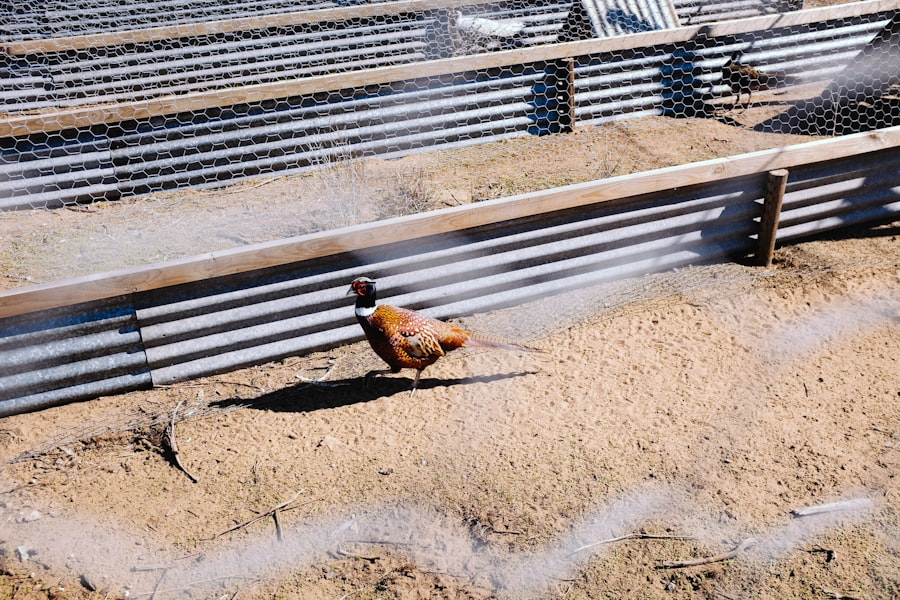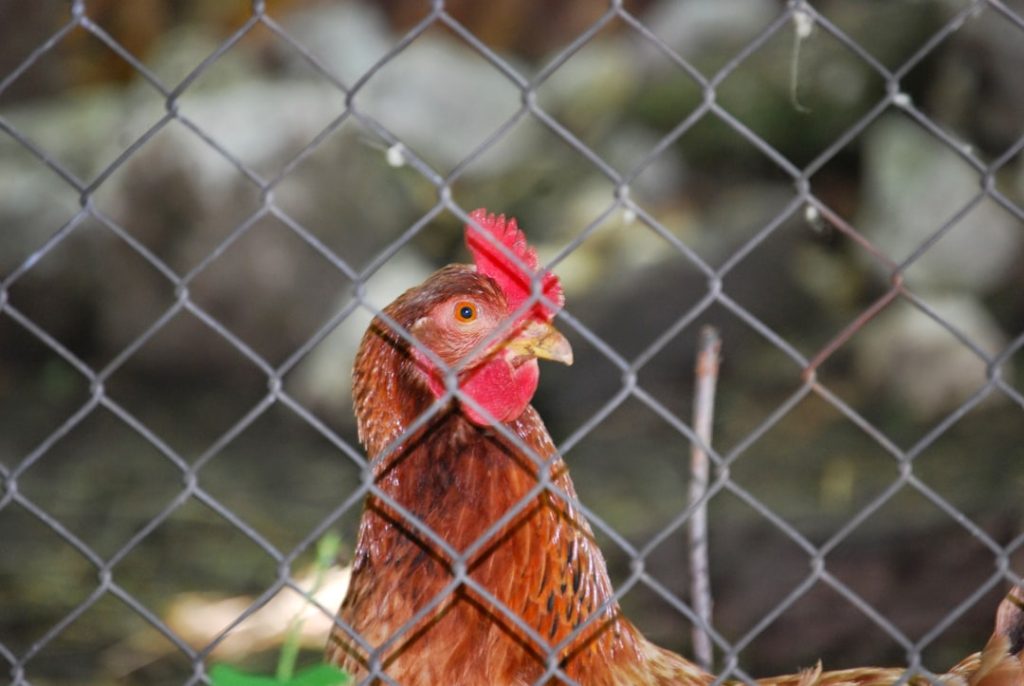Chickens are naturally curious and social animals with a strong instinct to forage for food. They are creatures of habit, typically returning to the same roosting spots and feeding areas. Understanding these behaviors is essential when attempting to deter chickens from unwanted areas.
Chickens are easily startled by sudden movements and loud noises, which can be utilized in deterrent methods. They also possess a strong sense of smell and can be repelled by certain scents, making repellents an effective tool for deterring them from specific areas. Chickens have the ability to adapt to their environment, necessitating consistent changes in deterrent methods to prevent habituation.
By comprehending chicken behavior, we can implement effective strategies to deter them from unwanted areas without causing harm. Chickens exhibit territorial behavior and may become aggressive when they feel threatened or when their territory is invaded. This territorial nature can pose a challenge when attempting to deter chickens from specific areas, as they may become more determined to access those spaces.
Understanding this behavior is crucial when implementing deterrent methods, as it allows for anticipation of the chickens’ reactions and adjustment of strategies accordingly. By gaining a thorough understanding of chicken behavior, we can develop effective and humane methods to deter them from unwanted areas.
Table of Contents
- 1 Implementing Physical Barriers
- 2 Using Repellents and Deterrents
- 3 Providing Alternative Roosting Areas
- 4 Removing Food Sources
- 5 Utilizing Sound and Motion to Scare Chickens
- 6 Seeking Professional Help if Necessary
- 7 FAQs
- 7.1 What are some effective ways to keep chickens off the porch?
- 7.2 Are there any natural repellents that can be used to keep chickens off the porch?
- 7.3 Is it possible to train chickens to stay off the porch?
- 7.4 What are some potential drawbacks of using physical barriers to keep chickens off the porch?
- 7.5 Are there any local regulations or ordinances that need to be considered when trying to keep chickens off the porch?
Key Takeaways
- Chickens are naturally curious and will explore their surroundings, so understanding their behavior is key to effectively managing them.
- Physical barriers such as fences and netting can help keep chickens out of unwanted areas and protect gardens and crops.
- Repellents and deterrents such as predator decoys and reflective tape can help discourage chickens from entering specific areas.
- Providing alternative roosting areas such as designated perches or shelters can help redirect chickens away from unwanted areas.
- Removing food sources such as spilled grains or uncovered compost can help reduce the attraction of chickens to specific areas.
- Utilizing sound and motion devices such as scarecrows or noise makers can help scare chickens away from unwanted areas.
- If chicken management becomes overwhelming, seeking professional help from a pest control or animal management service may be necessary.
Implementing Physical Barriers
Fences and Netting: Effective Deterrents
One effective way to deter chickens from unwanted areas is by implementing physical barriers. This can include installing fences, netting, or other structures to prevent chickens from accessing specific areas. Fences should be at least 6 feet high to prevent chickens from flying over them, and they should be buried at least 6 inches into the ground to prevent chickens from digging underneath them.
Protecting Specific Areas
Netting can also be used to cover specific areas, such as gardens or flower beds, to prevent chickens from foraging for food. Another physical barrier that can be effective in deterring chickens is the use of chicken wire or hardware cloth. These materials can be used to create barriers around specific areas, such as gardens or outdoor seating areas, to prevent chickens from accessing them.
Additional Deterrents and Safety Considerations
It’s important to ensure that the barriers are secure and properly installed to prevent chickens from finding ways to bypass them. In addition to fences and netting, physical barriers can also include the use of motion-activated sprinklers or other devices that startle chickens when they approach specific areas. These devices can be effective in deterring chickens from unwanted areas without causing harm to the animals.
Effective and Humane Deterrence
By implementing physical barriers, we can effectively prevent chickens from accessing specific areas while also ensuring their safety and well-being.
Using Repellents and Deterrents

Another effective method for deterring chickens from unwanted areas is by using repellents and deterrents. There are a variety of natural and commercial repellents that can be used to discourage chickens from accessing specific areas. Some common natural repellents include citrus peels, garlic, and hot peppers, which can be scattered around gardens or other areas to deter chickens from foraging for food.
Commercial repellents are also available and can be effective in deterring chickens from unwanted areas. These repellents often contain natural ingredients that are unpleasant to chickens, such as bittering agents or strong scents. They can be applied to specific areas or surfaces to discourage chickens from approaching them.
In addition to repellents, deterrents such as scarecrows or reflective tape can also be effective in deterring chickens from specific areas. Scarecrows can be placed in gardens or other areas where chickens are a problem, and their presence can startle the chickens and discourage them from approaching. Reflective tape can also be hung in specific areas to create movement and light reflections that startle chickens and deter them from accessing those areas.
By using a combination of natural and commercial repellents, as well as deterrents such as scarecrows and reflective tape, we can effectively deter chickens from unwanted areas without causing harm to the animals.
Providing Alternative Roosting Areas
One way to deter chickens from unwanted areas is by providing alternative roosting areas for them. Chickens have a natural instinct to roost in elevated areas at night, so providing alternative roosting spots can help prevent them from roosting in unwanted locations. This can include installing roosting bars or platforms in designated areas where chickens are allowed to roost, such as a chicken coop or designated roosting area.
Another way to provide alternative roosting areas for chickens is by installing nesting boxes or other structures that provide shelter and security for the birds. By providing comfortable and secure roosting spots for chickens, we can encourage them to roost in designated areas rather than in unwanted locations. It’s important to ensure that the alternative roosting areas are attractive to the chickens and meet their needs for comfort and security.
By providing alternative roosting spots that meet the chickens’ natural instincts and needs, we can effectively deter them from roosting in unwanted locations.
Removing Food Sources
Chickens are naturally drawn to areas where they can find food, so removing food sources can be an effective method for deterring them from unwanted areas. This can include securing garbage cans and compost bins to prevent chickens from accessing food scraps, as well as cleaning up spilled birdseed or other food sources that may attract the birds. In addition to securing food sources, it’s important to ensure that any potential food sources for chickens are removed or inaccessible.
This can include cleaning up fallen fruit or berries in gardens, as well as securing pet food and water dishes to prevent chickens from accessing them. By removing food sources and making sure that potential food sources are inaccessible, we can effectively deter chickens from unwanted areas without causing harm to the animals.
Utilizing Sound and Motion to Scare Chickens

Understanding Chicken Behavior
Chickens are easily startled by sudden movements and loud noises, making them susceptible to deterrent methods that utilize these stimuli.
Motion-Activated Devices
One effective way to deter chickens is by using motion-activated devices such as sprinklers or noise makers. These devices can startle the chickens when they approach specific areas, discouraging them from accessing those locations.
Visual Deterrents
Another method for utilizing sound and motion to scare chickens is by using visual deterrents such as predator decoys or reflective tape. These visual deterrents create movement and light reflections that startle the chickens and deter them from approaching specific areas.
By utilizing sound and motion to scare chickens away from unwanted areas, we can effectively deter them without causing harm to the animals.
Seeking Professional Help if Necessary
If all else fails, it may be necessary to seek professional help in deterring chickens from unwanted areas. Professional pest control companies or animal control services may have specialized knowledge and resources for effectively deterring chickens without causing harm to the animals. Professional help may also be necessary if the chicken infestation is particularly large or persistent, as it may require specialized techniques or equipment to effectively deter the birds.
By seeking professional help if necessary, we can ensure that the chicken infestation is effectively addressed without causing harm to the animals or the environment. In conclusion, understanding the behavior of chickens is crucial when trying to deter them from unwanted areas. By implementing physical barriers, using repellents and deterrents, providing alternative roosting areas, removing food sources, utilizing sound and motion to scare chickens, and seeking professional help if necessary, we can effectively deter chickens without causing harm to the animals.
If you’re looking for ways to keep chickens off your porch, you may also be interested in learning about what vegetables quails eat. Check out this article on Poultry Wizard to discover the best vegetables to feed your quails and keep them happy and healthy.
FAQs
What are some effective ways to keep chickens off the porch?
Some effective ways to keep chickens off the porch include using physical barriers such as fences or netting, using repellents such as citrus peels or vinegar, and training the chickens to stay away using positive reinforcement.
Are there any natural repellents that can be used to keep chickens off the porch?
Yes, natural repellents such as citrus peels, vinegar, or cayenne pepper can be used to deter chickens from coming onto the porch.
Is it possible to train chickens to stay off the porch?
Yes, chickens can be trained to stay off the porch using positive reinforcement techniques such as rewarding them for staying in designated areas and gently guiding them away from the porch when they approach.
What are some potential drawbacks of using physical barriers to keep chickens off the porch?
Potential drawbacks of using physical barriers to keep chickens off the porch include the cost of installation, the visual impact on the porch’s aesthetics, and the need for regular maintenance to ensure the barriers remain effective.
Are there any local regulations or ordinances that need to be considered when trying to keep chickens off the porch?
It’s important to check local regulations or ordinances regarding the keeping of chickens and the use of deterrents or barriers on porches to ensure compliance with any relevant laws or guidelines.
Meet Walter, the feathered-friend fanatic of Florida! Nestled in the sunshine state, Walter struts through life with his feathered companions, clucking his way to happiness. With a coop that’s fancier than a five-star hotel, he’s the Don Juan of the chicken world. When he’s not teaching his hens to do the cha-cha, you’ll find him in a heated debate with his prized rooster, Sir Clucks-a-Lot. Walter’s poultry passion is no yolk; he’s the sunny-side-up guy you never knew you needed in your flock of friends!







